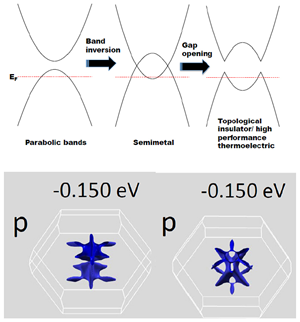
Thermoelectric materials enable scalable direct conversion of heat to electricity in solid state devices, and have potential for recovering a portion of the energy that is lost as waste heat. ORNL researchers showed how the dual requirement of high conductivity and high thermopower can be met through iso-energy surfaces with complex shapes and large surface-to-volume ratios. This complex electronic structure is in contrast to that of typical semiconductors, which have simple spherical or ellipsoidal iso-energy surfaces. The work advances understanding of the known high performance of Bi2Te3, provides a design principle for discovering new thermoelectrics, and establishes a long-suspected connection between topological insulators and thermoelectrics.
H. Shi, D. Parker, M. H. Du, and D. J. Singh, “Connecting thermoelectric performance and topological insulator behavior: Bi2Te3 and Bi2Te2Se from first principles,” Physical Review Applied 3, 014004 (2015). DOI: 10.1103/PhysRevApplied.3
For more information

